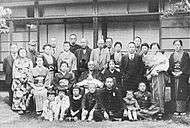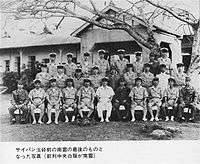Chūichi Nagumo
| Chūichi Nagumo | |
|---|---|
 Vice Admiral Chūichi Nagumo | |
| Born |
March 25, 1887 Yonezawa, Yamagata Japan |
| Died |
July 6, 1944 (aged 57)[1] Saipan, Northern Mariana Islands |
| Allegiance |
|
| Service/branch |
|
| Years of service | 1908–1944 |
| Rank | Admiral |
| Unit | Kido Butai |
| Commands held |
Aki, Hatsuyuki, Kirishima, Sugi, Kisaragi, Momi, Naka, Takao, Yamashiro 11th Destroyer Division, 8th Cruiser Division, 3rd Battleship Division, Kido Butai, 1st Carrier Division, First Air Fleet, IJN 3rd Fleet, Sasebo Naval District, Kure Naval District, First Fleet, Central Pacific Area Fleet, Fourteenth Air Fleet[2] |
| Battles/wars |
World War II Attack on Pearl Harbor Bombing of Darwin Indian Ocean Raid Battle of Midway Battle of the Eastern Solomons Battle of the Santa Cruz Islands |
| Awards |
Order of the Rising Sun (3rd class) Order of the Rising Sun (4th class) Order of the Golden Kite (3rd class) Grand Cordon of the Order of the Sacred Treasure (1st class)[2] |
Chūichi Nagumo (南雲 忠一 Nagumo Chūichi, March 25, 1887 – July 6, 1944) was a Japanese admiral in the Imperial Japanese Navy (IJN) during World War II and onetime commander of the Kido Butai (the carrier battle group).[3] He committed suicide during the Battle of Saipan.
Biography
Early life

Nagumo was born in the city of Yonezawa, Yamagata Prefecture in northern Japan in 1887. He graduated from the 36th class of the IJN Academy in 1908, with a ranking of 8 out of a class of 191 cadets. As a midshipman, he served in the protected cruisers Soya and Niitaka and the armored cruiser Nisshin. After his promotion to ensign in 1910, he was assigned to cruiser Asama.
After attending torpedo and naval artillery schools, he was promoted to sub-lieutenant and served in the battleship Aki, followed by the destroyer Hatsuyuki. In 1914, he was promoted to lieutenant and was assigned to the battlecruiser Kirishima, followed by the destroyer Sugi. He was assigned his first command, the destroyer Kisaragi, on 15 December 1917.
Nagumo graduated from the Naval War College, and was promoted to lieutenant commander in 1920. His specialty was torpedo and destroyer tactics. From 1920 to 1921, he was captain of the destroyer Momi, but was soon sent to shore duty with various assignments by the IJN General Staff. He became a commander in 1924. From 1925 to 1926, Nagumo accompanied a Japanese mission to study naval warfare strategy, tactics, and equipment in Europe and the United States.

After his return to Japan, Nagumo was appointed captain of the river gunboat Saga from 20 March 1926 to 15 October 1926, followed by the gunboat Uji from 15 October 1926 to 15 November 1927. He then served as an instructor at the IJN Academy from 1927 to 1929. Nagumo was promoted to captain in November 1929 and assumed command of the light cruiser Naka and from 1930 to 1931 was commander of the 11th Destroyer Division. After serving in administrative positions from 1931 to 1933, he assumed command of the heavy cruiser Takao from 1933 to 1934, and the battleship Yamashiro from 1934 to 1935. He was promoted to rear admiral on 1 November 1935.
As a Rear Admiral, Nagumo commanded the 8th Cruiser Division to support Imperial Japanese Army movements in China from the Yellow Sea. As a leading officer of the militaristic Fleet Faction, he also received a boost in his career from political forces.
From 1937 to 1938, he was Commandant of the Torpedo School, and from 1938 to 1939, he was commander of the 3rd Cruiser Division. Nagumo was promoted to vice admiral on 15 November 1939. From November 1940-April 1941, Nagumo was Commandant of the Naval War College.
World War II
On 10 April 1941, Nagumo was appointed commander-in-chief of the First Air Fleet, the IJN′s main aircraft carrier force, largely due to his seniority. Many contemporaries and historians have doubted his suitability for this command, given his lack of familiarity with naval aviation.
By this time, he had visibly aged, physically and mentally. Physically, he suffered from arthritis, perhaps from his younger days as a kendoka.[4] Mentally, he had become a cautious officer who worked much going over tactical plans of every operation he was involved in.
Admiral Nishizo Tsukahara had doubts about Nagumo's appointment, and commented, "Nagumo was an officer of the old school, a specialist of torpedo and surface maneuvers.... He did not have any idea of the capability and potential of naval aviation." One son of Nagumo described him as a brooding father, obsessed with and later regretful about pressuring his sons into the IJN. By contrast, Nagumo's junior naval officers thought of him as a father figure.[4]
Despite his limited experience, he was a strong advocate of combining sea and air power although he was opposed to Admiral Isoroku Yamamoto's plan to attack the U.S. Naval installation at Pearl Harbor.[5] While commanding the First Air Fleet, Nagumo oversaw the attack on Pearl Harbor, but he was later criticized for his failure to launch a third attack,[6] which might have destroyed the fuel oil storage and repair facilities. This could have rendered the most important US naval base in the Pacific useless, especially as the use of the submarine base and intelligence station at the installation were critical factors in Japan's defeat.[7]
Nagumo was surrounded by able lieutenants such as Minoru Genda and Mitsuo Fuchida. He also fought well in the early 1942 campaigns. The success while fleet commander, the bombing of Darwin and the Indian Ocean raid on the British Eastern Fleet sank an aircraft carrier, two cruisers and two destroyers, and caused Admiral Sir James Somerville to retreat to East Africa.
At the end of his deployment into the Indian Ocean, Nagumo's military strike score card saw five battleships, one carrier, two cruisers, seven destroyers, dozens of merchantmen, transports, and various other vessels disabled or destroyed; He also oversaw the downing of hundreds of aircraft from six Allied nations. Allied ports were also disabled or destroyed and hindered Allied operations. All this and his losses were no more than a few dozen pilots[4] by the time of the Battle of Midway.
Midway brought Nagumo's near-perfect record to an end. His Carrier Striking Task Force lost four carriers during the turning point of the Pacific War, and the massive losses of carrier aircraft maintenance personnel would prove detrimental to the performance of the IJN in later engagements. It was the loss of the four carriers, their aircraft, and the maintenance crew that was more cataclysmic than the 110 carrier aircrew who were lost during the battle.
Afterwards, Nagumo was reassigned as commander-in-chief of the Third Fleet and commanded aircraft carriers in the Guadalcanal campaign, although there his actions were largely indecisive and slowly frittered away much of Japan's maritime strength.
Final days

On 11 November 1942, Nagumo was reassigned to Japan, where he was given command of the Sasebo Naval District. He transferred to the Kure Naval District on 21 June 1943. From October 1943 to February 1944, Nagumo was again commander-in-chief of First Fleet, which was by that time largely involved in only training duties.
As Japan's military situation deteriorated, Nagumo was deployed on 4 March 1944 for the short-lived commander-in-chief in the Mariana Islands of the Fourteenth Air Fleet and the Central Pacific Area Fleet.
The Battle of Saipan began on 15 June 1944. The IJN, under Vice Admiral Jisaburō Ozawa, was overwhelmed within days by the U.S. 5th Fleet in the decisive Battle of the Philippine Sea, where Japan lost three fleet carriers and about 600 aircraft. Nagumo and his Army peer General Yoshitsugu Saito then were on their own to keep control of Saipan. On 6 July, Nagumo committed suicide with a pistol to the temple rather than the traditional seppuku. His remains were recovered by the U.S. Marines in the cave where he spent his last days as the Japanese commander of Saipan.[8] He was posthumously promoted to admiral.
Promotions
| IJN Insignia | Rank | Date |
|---|---|---|
| 海軍少尉候補生 Kaigun Shōi Kōhōsei (Midshipman) |
21 November 1908 | |
.gif) |
海軍少尉 Kaigun Shōi (Ensign) |
15 January 1910 |
.gif) |
海軍中尉 Kaigun Chūi (Sub-Lieutenant/Lieutenant Junior Grade) |
1 December 1911 |
 |
海軍大尉 Kaigun Daii (Lieutenant) |
1 December 1914 |
.gif) |
海軍少佐 Kaigun Shōsa (Lieutenant-Commander) |
1 December 1920 |
 |
海軍中佐 Kaigun Chūsa (Commander) |
1 December 1924 |
 |
海軍大佐 Kaigun Daisa (Captain) |
30 November 1929 |
 |
海軍少将 Kaigun Shōshō (Rear-Admiral) |
15 November 1935 |
 |
海軍中将 Kaigun Chūjō (Vice-Admiral) |
15 November 1939 |
 |
海軍大将 Kaigun Taishō (Admiral) |
8 July 1944 (Posthumous)[1] |
In popular culture
- In the 1970 film Tora! Tora! Tora!, Nagumo was portrayed by Japanese actor Eijirō Tōno.
- In the 1976 film Midway, Nagumo was portrayed by American actor James Shigeta.
- In the 2004 video game Axis and Allies, Nagumo is one of four playable Japanese commanders, alongside his more famous superior, Yamamoto.
Notes
- 1 2 Nishida, Imperial Japanese Navy
- 1 2 Nagumo Chuichi at navalhistory.flixco.info
- ↑ Klemen, L. "Vice-Admiral Chuichi Nagumo". Forgotten Campaign: The Dutch East Indies Campaign 1941–1942.
- 1 2 3 World War II Database page on Nagumo.
- ↑ Evans, Kaigun, p. 529
- ↑ Blair, Clay, Jr. Silent Victory (Lippincott, 1975); Willmott, H. P. Barrier and the Javelin (United States Naval Institute Press, 1983); Holmes, W. J. Double-Edged Secrets (United States Naval Institute Press, 1979).
- ↑ Blair, passim; Holmes, passim.
- ↑ Breaching the Marianas: The Battle for Saipan
References
- D'Albas, Andrieu (1965). Death of a Navy: Japanese Naval Action in World War II. Devin-Adair Pub. ISBN 0-8159-5302-X.
- Dull, Paul S. (1978). A Battle History of the Imperial Japanese Navy, 1941-1945. Naval Institute Press. ISBN 0-87021-097-1.
- Denfeld, D. Colt (1997). Hold the Marianas: The Japanese Defense of the Mariana Islands. White Mane Pub. ISBN 1-57249-014-4.
- Evans, David (1979). Kaigun: Strategy, Tactics, and Technology in the Imperial Japanese Navy, 1887-1941. US Naval Institute Press. ISBN 0-87021-192-7.
- Goldberg, Harold J. (2007). D-day in the Pacific: The Battle of Saipan. Indiana University Press. ISBN 0-253-34869-2.
- Jones, Don (1986). Oba, The Last Samurai. Presidio Press. ISBN 0-89141-245-X.
- Morison, Samuel Eliot (2001). New Guinea and the Marianas, March 1944-August 1944, vol. 8 of History of United States Naval Operations in World War II (reissue ed.). Champaign, Illinois, USA: University of Illinois Press. ISBN 0-252-07038-0.
External links
| Wikiquote has quotations related to: Chūichi Nagumo |
- Vice Admiral Chuichi Nagumo, IJN, (1886-1944)
- Beyond the Movie: Pearl Harbor
- WW2DB: Chuichi Nagumo
- Breaching the Marianas: The Battle for Saipan (Marines in World War II Commemorative Series)
- Nishida, Hiroshi. "Materials of IJN: Nagumo, Chuichi". Imperial Japanese Navy. Retrieved 2007-08-03.
|